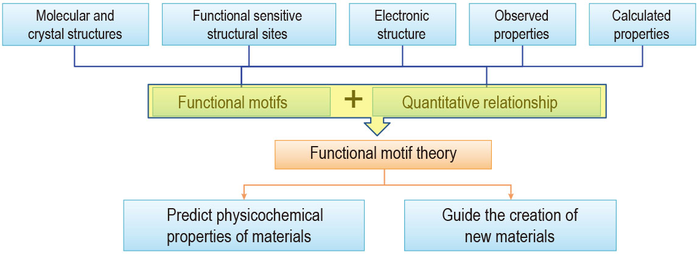The typical trial-and-error technique of material research is unable to fulfill the expanding demand for a variety of high-performance materials; a new effective material science paradigm is urgently needed.
 The paradigm starts with the main aspects of microscopic structures and the properties materials. On the basis of which the functional motifs governing the material properties can be extracted and the quantitative relationships between them can be investigated, and the results could be further developed as the “functional motif theory”. The latter should be useful as a guideline for creating new materials and as a tool for predicting the physicochemical properties of materials. Image Credit: Science China Press.
The paradigm starts with the main aspects of microscopic structures and the properties materials. On the basis of which the functional motifs governing the material properties can be extracted and the quantitative relationships between them can be investigated, and the results could be further developed as the “functional motif theory”. The latter should be useful as a guideline for creating new materials and as a tool for predicting the physicochemical properties of materials. Image Credit: Science China Press.
Based on the “functional motif” idea, a study conducted by Dr. Xiao-Ming Jiang and Prof Guo-Cong Guo (Fujian Institute of Research on the Structure of Matter, Chinese Academy of Sciences) presents a new research paradigm for material studies.
The significant microstructure units (e.g., constituent components and building blocks) that play an important role in creating particular material functions were designated as functional motifs. Without losing or considerably decreasing the required functionality, these units could not be substituted with alternative structural units. The functional motif paradigm (see diagram below) begins with the fundamentals of microscopic structures and material characteristics.
The functional motifs influencing material qualities may be retrieved and the quantitative correlations between them can be examined, and the results can be developed further as the “functional motif theory.” The latter should help develop novel materials as well as a tool for forecasting material physicochemical features.
The functional motifs of materials and how they are ordered in the materials affect their characteristics, with the latter establishing the quantitative structure-property connections. Understanding the characteristics of materials requires the identification of functional motifs and their configurations, and functional motif study allows for the logical creation of novel materials with desired features.
Given the significance of microscopic structures in the functional motif paradigm, a thorough understanding of material structures is required. Information crosses multiple lengths and time scales in the hierarchy of material structure. Material structures are divided into mesoscopic, macroscopic and microscopic structures by Jiang X-M et al, while microscopic structures are further divided into six categories by Jiang X-M et al.
The crystal, aperiodic, magnetic, local, defect and electronic structures are all examples of this. Jiang X-M et al show the importance of functional motifs and their arrangements in defining characteristics using typical functional materials for each type of microscopic structure.
Jiang X-M et al used Infrared (IR) NLO materials as an example of a function-oriented design method for novel functional materials, which emphasizes the importance of functional motifs in material design. This approach is distinct from the typical structure-oriented design approach.
Jiang X-M et al. also emphasized the importance of high-throughput experimentation and computation in material studies, as well as the difficulties in deriving functional motifs from vast amounts of data on material structures and characteristics. Machine learning is projected to be beneficial in predicting material qualities and screening materials with desired properties more efficiently.
It is critical to develop sufficiently robust material structures and property databases, as well as novel effective ways for extracting functional motifs and material structure-property connections from machine learning models, to design new materials.
Journal Reference:
Jiang, X-M., et al. (2022) Material research from the viewpoint of functional motifs. National Science Review. doi.org/10.1093/nsr/nwac017.